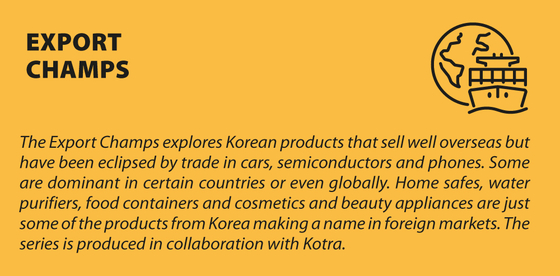From cookout to kimchi jjigae, gas canisters prove a hit overseas
전체 맥락을 이해하기 위해서는 본문 보기를 권장합니다.
"In the case of Japan, demand for portable butane gas far exceeds supply," Yoo said. "Shipments to Japan peaked after the 1995 Kobe earthquake and the 2011 Tohoku earthquake. After the events, shipment to Japan gradually rose."
"But the products started being sold across the world — starting with developed countries and spreading to developing countries — led by immigrants."
이 글자크기로 변경됩니다.
(예시) 가장 빠른 뉴스가 있고 다양한 정보, 쌍방향 소통이 숨쉬는 다음뉴스를 만나보세요. 다음뉴스는 국내외 주요이슈와 실시간 속보, 문화생활 및 다양한 분야의 뉴스를 입체적으로 전달하고 있습니다.
![Butane gas canisters are produced at Daeryuk's production line in Asan, South Chungcheong. [DAERYUK]](https://img3.daumcdn.net/thumb/R658x0.q70/?fname=https://t1.daumcdn.net/news/202109/15/koreajoongangdaily/20210915191504473wsxz.jpg)

Disposable butane gas canisters play a surprisingly big role in Korean life, from camping trips and cookouts to the local kimchi jjigae restaurant.
These small, cheap-to-buy canisters have also grown into a major export item as two Korean companies — Taeyang and Daeryuk — account for over 70 percent of the market share globally, according to the Korea Trade-Investment Investment Promotion Agency (Kotra).
While domestic demand has been steady for years, shipments of butane canisters have gradually increased, especially over the past decade.

The first production of portable butane fuel dates back to the late 1960s in Japan and a company called Iwatani. Japan, however, now stands as the top importing country of butane from Korea, the majority of which is through butane gas canisters, bringing in $41.8 million worth of imports last year. The United States came second with $20 million in imports, according to Kotra, followed by China at $12.9 million.
According to Yoo Chang-rai, managing director of the overseas business division at Taeyang, Korea's market dominance comes down to two things: Prices and production.
"Our competitiveness lies in our cheaper price and our production facilities that exclusively produce portable butane canisters, which are able to supply a large volume of butane gas canisters in a stable manner," Yoo said.
Another reason for the success of Korean gas canisters is the growing popularity of Korean food. Eating out gained a huge boost in popularity in Korea during the 1988 Seoul Olympics, and restaurants quickly started using portable stoves to offer an at-table heat source without the need for expensive equipment.
As the popularity of Korean food grew globally, that portable stove tradition began to travel around the world, breaking down the idea that butane stoves are only for camping and emergencies.
Still, the demand linked with the emergency state paved way for export to Korean producers, according to Yoo.
Taeyang, the world’s largest producer of portable butane canisters in terms of market share, started exporting the item to Japan in the 1980s when the neighboring country was struggling with a supply shortage.
“In the case of Japan, demand for portable butane gas far exceeds supply,” Yoo said. “Shipments to Japan peaked after the 1995 Kobe earthquake and the 2011 Tohoku earthquake. After the events, shipment to Japan gradually rose."
Japan accounted for around 40 percent of Taeyang’s entire overseas sales last year, followed by the United States at 10 percent.
![Sun butane canisters produced by Taeyang [TAEYANG]](https://img2.daumcdn.net/thumb/R658x0.q70/?fname=https://t1.daumcdn.net/news/202109/15/koreajoongangdaily/20210915191508159rldd.jpg)
Besides the primary markets, Taeyang sells its Sun butane cartridges to over 70 countries, with its focus on retailing the products that comply with each market’s rules and safety standards.
Daeryuk, the second largest producer, also first targeted Japan and then extended its reach to countries like the United States, China and Australia, where a large number of Korean immigrants live.
“Until the 1990s and 2000s, the portable stoves and butane gas were not yet popularized except for specific countries like Korea and Japan,” said a spokesperson at Daeryuk.
“But the products started being sold across the world — starting with developed countries and spreading to developing countries — led by immigrants."
Japan still accounts for 20 percent of Daeryuk’s overseas sales, although the spokesperson added that the reliance has been eased with its exporting destinations diversified.
The U.S. accounts for 12 percent, followed by China with 9 percent. Australia and Taiwan each account for about 6 percent of sales.
Daeryuk’s latest target markets include developing countries in Asia as the unstable supply of utility services boosts appeal of portable stoves.
Myanmar, for instance, has seen a drastic increase in imports of butane gas since 2010 as people transitioned from the traditional fire pit.
“Myanmar suffers from chronic power shortages, so there is a limitation to the country’s access to electric kitchen appliances,” a report from Kotra said.
“Therefore, Myanmar will quickly move toward portable gas burners with the increased disposable income.”
Imports of Korean-made butane gas to Myanmar reached $422,000 in 2015, up 309.7 percent compared to 2010, according to the trade agency.
Daeryuk said that it will continue to target new markets with its Max butane products fitted with explosion-prevention functions.
“Starting in 2010, we zeroed in on entering new markets like Russia, the Middle East and China, which pushed up overseas sales,” the spokesperson said. “We also entered remote islands in the Pacific Ocean to a great success.”
BY PARK EUN-JEE [park.eunjee@joongang.co.kr]
Copyright © 코리아중앙데일리. 무단전재 및 재배포 금지.
- 'The Kelly Clarkson Show' under fire for photo mix-up of BTS
- BTS to join Moon at UN General Assembly as presidential special envoy
- Kakao responds to heat, promises generosity
- Young people’s deaths after Pfizer vaccines are new worry
- Exes or soon-to-be singletons take chance at finding new love... together
- China 'stabs itself in the eye' with pop culture regulations
- Healthy man in 30s dies after first Pfizer dose
- LG Chem and Archer Daniels Midland to build PLA factory
- Moon among 12,000 to order Hyundai Casper on opening day
- Samsung settles on Taylor, Texas as site for new chip plant